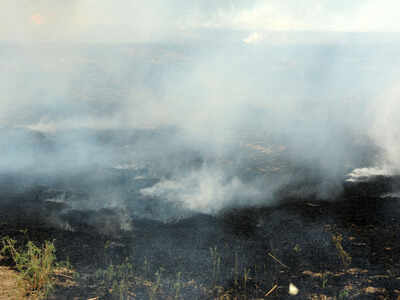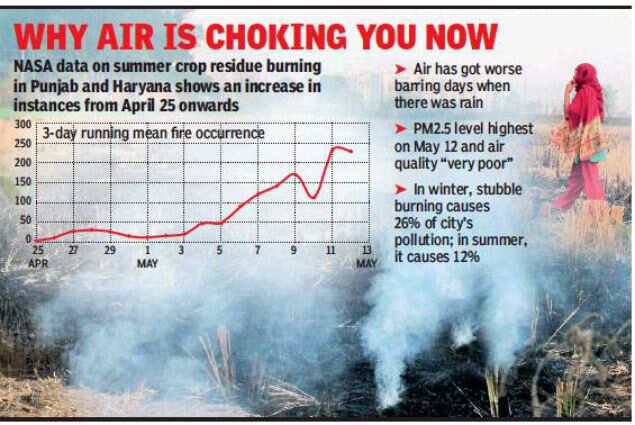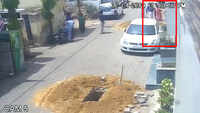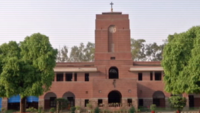
NEW DELHI: Stubble burning in Punjab and Haryana is once again hurting the city’s air quality. Even though rain has brought down the pollution level, System of Air Quality and Weather Forecasting and Research (SAFAR), a body under Union ministry of earth sciences, said that the city air will get fouler in the next couple of days due to burning of the crop residue.
Track the pollution level in your city
“By May 17, upper winds are likely to bring some impact of stubble burning from north India, which is at its peak. However, unlike winter, ventilation coefficient is high enough to disperse the pollutants quickly. The air quality is predicted to be at the higher end of moderate category to the lower end of poor for the next three days,” a SAFAR report on Wednesday stated.

Data from NASA Moderate Resolution Imaging Spectroradiometer (MODIS) on summer crop residue burning in Punjab and Haryana shows an increase in instances from April 25 onwards. At the same time, PM2.5 readings were fouler, barring days when rain hit the city. On May 12, the PM2.5 level was at the highest (164.46mg/m3) and AQI at 334 (very poor).
In India, crop residue burning occurs after harvest, in October or November for wheat and in April or May for rice. This impacts the air quality of Delhi. In winter, stubble burning causes 26% of the city’s pollution, while in summer it goes down to 12%.
There have been reports of stubble burning closer home in Greater Noida and outer Delhi. “It happens regularly in farms along Yamuna Expressway. I had raised the matter with National Green Tribunal. Even though there is a ban, nothing much has been done on the ground,” environmental activist Vikrant Tongad said.
Anumita Roychowdhury, head of air pollution and clean transportation programme at Centre for Science and Environment, said wind direction is important and the impact in summer is not that high as compared to winter as pollution doesn’t get trapped.
“There is a need to look at solution at source. Wheat straw has more fodder value. Summer will be different from winter and the variability of impact depends on the direction and speed of wind. Strategies can be the same with a scaled down approach,” Roychowdhury said.
Earlier this month, NGT had directed the Union ministry of agriculture to furnish a status report on the steps taken to stop crop residue burning. “Before taking coercive measures, we give an opportunity to the ministry of agriculture to furnish its report within two weeks by e-mail at ngt.filing@gmail.com, failing which we may have to enforce personal appearance of the ministry secretary and take penal action,” the bench had said.
Track the pollution level in your city
“By May 17, upper winds are likely to bring some impact of stubble burning from north India, which is at its peak. However, unlike winter, ventilation coefficient is high enough to disperse the pollutants quickly. The air quality is predicted to be at the higher end of moderate category to the lower end of poor for the next three days,” a SAFAR report on Wednesday stated.

Data from NASA Moderate Resolution Imaging Spectroradiometer (MODIS) on summer crop residue burning in Punjab and Haryana shows an increase in instances from April 25 onwards. At the same time, PM2.5 readings were fouler, barring days when rain hit the city. On May 12, the PM2.5 level was at the highest (164.46mg/m3) and AQI at 334 (very poor).
In India, crop residue burning occurs after harvest, in October or November for wheat and in April or May for rice. This impacts the air quality of Delhi. In winter, stubble burning causes 26% of the city’s pollution, while in summer it goes down to 12%.
There have been reports of stubble burning closer home in Greater Noida and outer Delhi. “It happens regularly in farms along Yamuna Expressway. I had raised the matter with National Green Tribunal. Even though there is a ban, nothing much has been done on the ground,” environmental activist Vikrant Tongad said.
Anumita Roychowdhury, head of air pollution and clean transportation programme at Centre for Science and Environment, said wind direction is important and the impact in summer is not that high as compared to winter as pollution doesn’t get trapped.
“There is a need to look at solution at source. Wheat straw has more fodder value. Summer will be different from winter and the variability of impact depends on the direction and speed of wind. Strategies can be the same with a scaled down approach,” Roychowdhury said.
Earlier this month, NGT had directed the Union ministry of agriculture to furnish a status report on the steps taken to stop crop residue burning. “Before taking coercive measures, we give an opportunity to the ministry of agriculture to furnish its report within two weeks by e-mail at ngt.filing@gmail.com, failing which we may have to enforce personal appearance of the ministry secretary and take penal action,” the bench had said.
Make sense of the 2019 Lok Sabha elections and results on May 23 with TOI. Follow us to track latest news, live updates, news analysis and cutting-edge data analytics. Track live election results, the big trends and fastest updates on counting day with India's largest news network.
#ElectionsWithTimes
Elections 2019

Trending Topics
LATEST VIDEOS
City
 Caught on cam: BSP councillor’s husband threatens woman by brandishing gun in Meerut
Caught on cam: BSP councillor’s husband threatens woman by brandishing gun in Meerut  Primary school teacher at Agra allegedly failed to say how many alphabets in Hindi and English
Primary school teacher at Agra allegedly failed to say how many alphabets in Hindi and English  Mumbai: Woman claims constable stripped in front of her
Mumbai: Woman claims constable stripped in front of her  Tanker carrying kerosene overturns near Warje flyover bridge, creates chaos on roads
Tanker carrying kerosene overturns near Warje flyover bridge, creates chaos on roads
More from TOI
Navbharat Times
Featured Today in Travel
Quick Links
Lok Sabha Election Schedule 2019Lok Sabha Election NewsDelhi Capitals teamMI team 2019Rajasthan Royals 2019RCB team 2019Maharashtra Lok Sabha ConstituenciesBJP Candidate ListBJP List 2019 TamilnaduShiv Sena List 2019AP BJP List 2019Mamata BanerjeeBJP List 2019 MaharashtraPriyanka GandhiBJP List 2019 KarnatakaAMMK Candidate List 2019BJP List 2019 WBLok Sabha Elections in Tamil NaduBSP List 2019 UPNews in TamilLok Sabha Poll 2019Satta Matka 2018PM ModiMahagathbandhanNagpur BJP Candidate ListChandrababu NaiduTamil Nadu ElectionsUrmila MatondkarNews in TeluguMadras High CourtTejashwi YadavArvind KejriwalTejasvi SuryaPawan KalyanArvind KejriwalYogi AdityanathJaya PradaSatta King 2019Srinagar encounter
Get the app






